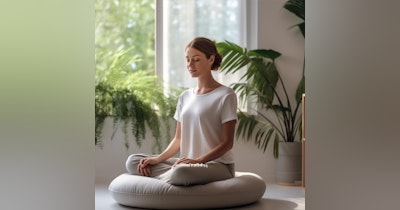This ancient meditation practice has been used for centuries to promote inner peace, reduce stress, and increase overall well-being. By focusing on your breath and observing it without judgment, you can train your mind to be more present and less reactive to external stressors.
GET STARTED TODAY WITHOUT ANY RISK!
Get 7 Days of Unlimited Access Right Now
for Free When You Download Our App!
A life of transformation begins with action. There are seven stages of meditation instruction on a single platform. Live monthly Zoom coaching and training sessions.
Get unlimited free access to the Meditation Life Skills app for 7 days by downloading it now! Visit MeditationLifeSkills.com.
Are you tired of feeling overwhelmed by stress and anxiety? Do you find it difficult to quiet your mind and relax? If so, you may benefit from practicing breath awareness meditation.
In this article, we will explore the benefits of breath awareness meditation, how to get started, and tips for incorporating this practice into your daily routine.
Whether you're a seasoned meditator or new to the practice, breath awareness meditation can be a powerful tool for managing stress and anxiety and living a more balanced life. Let's dive in.
How Breath Awareness Meditation Works
Breath awareness meditation is a simple yet powerful technique for reducing stress and anxiety. In this practice, you focus your attention on your breath and observe it without judgment.
As you breathe in and out, you become more aware of your thoughts and emotions, and you learn to respond to them in a more calm and balanced way.
Research has shown that breath awareness meditation can change the way your brain responds to stress. It activates the parasympathetic nervous system, which is responsible for rest and relaxation, and reduces the activity of the sympathetic nervous system, which is responsible for the fight or flight response. This leads to a decrease in cortisol levels and an increase in feelings of calm and well-being.
The Benefits of Breath Awareness Meditation
Breath awareness meditation has numerous benefits for your physical and mental health.
Here are some of the most compelling:
Reduces Stress and Anxiety
Breath awareness meditation is a proven way to reduce stress and anxiety. By focusing on your breath, you can quiet your mind and let go of worries and distractions. This can help you feel more relaxed and less reactive to external stressors.
Improves Mental Clarity and Focus
When you practice breath awareness meditation, you become more aware of your thoughts and emotions. This can help you develop greater mental clarity and focus. You may find it easier to concentrate on tasks and make decisions.
Enhances Emotional Resilience
Breath awareness meditation can help you develop greater emotional resilience. By observing your thoughts and emotions without judgment, you can learn to respond to them in a more balanced way. This can help you cope with difficult situations and bounce back from setbacks.
Boosts Immune Function
Research has shown that breath awareness meditation can boost immune function. By reducing stress and anxiety, it can help your body fight off infections and other illnesses.
Promotes Better Sleep
Breath awareness meditation can also help you sleep better. By calming your mind and body, it can promote deeper relaxation and more restful sleep.
Getting Started with Breath Awareness Meditation
If you're new to breath awareness meditation, it can be helpful to start with a guided meditation. You can find free guided meditations online or through meditation apps.
Here are some tips for getting started:
Find a Quiet Space
Choose a quiet space where you won't be disturbed. You can sit on a cushion or chair with your back straight and your feet on the ground.
Set a Time Limit
Start with a short meditation, such as 5-10 minutes. Gradually increase the length of your meditation as you become more comfortable with the practice.
Focus on Your Breath
Close your eyes and focus your attention on your breath. Observe the sensation of air moving in and out of your nostrils or the rise and fall of your chest.
Notice Thoughts and Emotions
As you meditate, you may notice thoughts and emotions arising. Simply observe them without judgment and let them pass by.
Return to Your Breath
If you become distracted by thoughts or emotions, gently return your focus to your breath. This is a normal part of the practice, so don't be hard on yourself.
Breath Awareness Meditation Techniques
There are many different techniques you can use in breath awareness meditation. Here are a few to try:
Counting
As you breathe in and out, count each breath up to 10. Then start again at 1. This can help you focus your attention on your breath and prevent distractions.
Visualization
Imagine yourself inhaling positive energy and exhaling negative energy as you breathe. This visualization can help you cultivate feelings of calm and well-being.
Mantra
Choose a Mantra word or phrase, such as "peace" or "let go," and repeat it silently to yourself as you breathe. This can help you stay focused and calm.
Tips for a Successful Breath Awareness Meditation Practice
Here are some tips for making the most of your breath awareness meditation practice:
Practice Regularly
Try to meditate at the same time each day, such as in the morning or before bed. This can help you establish a routine and make meditation a habit.
Be Patient
Meditation takes practice, so be patient with yourself. Don't worry if your mind wanders or if you feel restless at first. Over time, you'll become more comfortable with the practice.
Be Consistent
Consistency is key to seeing the benefits of meditation. Even if you can only meditate for a few minutes each day, try to do it consistently.
Be Kind to Yourself
Don't judge yourself for having thoughts or emotions during meditation. Instead, be kind and compassionate toward yourself.
Common Misconceptions about Breath Awareness Meditation
Here are some common misconceptions about breath awareness meditation:
You Need to Clear Your Mind
Many people think they need to clear their mind completely during meditation. However, this is not the case. The goal of meditation is to observe your thoughts and emotions without judgment, not to eliminate them altogether.
You Need to Sit Cross-Legged
While sitting cross-legged can be a comfortable position for some people, it's not necessary for breath awareness meditation. You can sit in any position that feels comfortable for you.
Meditation is Only for Spiritual People
Meditation is a secular practice that can benefit people of all backgrounds and beliefs. You don't need to be spiritual or religious to practice meditation.
How to Incorporate Breath Awareness Meditation into Your Daily Routine
Here are some tips for incorporating breath awareness meditation into your daily routine:
Start Small
Start with a short meditation, such as 5-10 minutes, and gradually increase the length of your meditation as you become more comfortable with the practice.
Make It a Habit
Try to meditate at the same time each day, such as in the morning or before bed. This can help you establish a routine and make meditation a habit.
Meditate Anywhere
You can meditate anywhere, such as at home, at work, or in nature. Find a quiet space where you won't be disturbed and make it your meditation spot.
Use Guided Meditations
Guided meditations can be a helpful way to get started with breath awareness meditation. You can find free guided meditations online or through meditation apps.
Conclusion and Next Steps
Breath awareness meditation is a powerful tool for reducing stress and anxiety and promoting overall well-being. By focusing on your breath and observing it without judgment, you can train your mind to be more present and less reactive to external stressors.
Whether you're a seasoned meditator or new to the practice, breath awareness meditation can be a valuable addition to your daily routine.
To get started, find a quiet space, set a time limit, and focus on your breath. With practice, you can cultivate greater calm, clarity, and resilience in your daily life.















